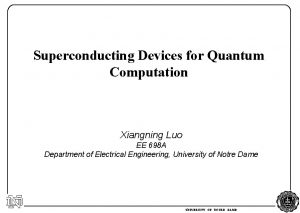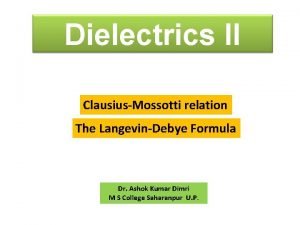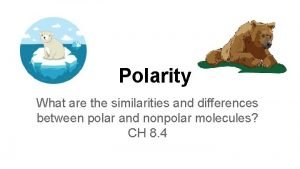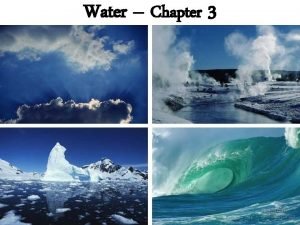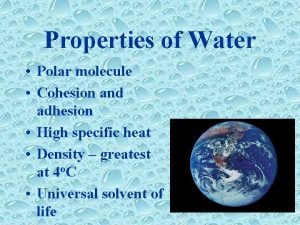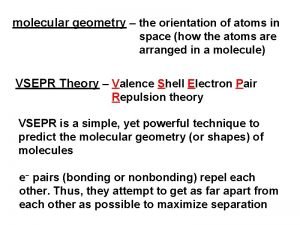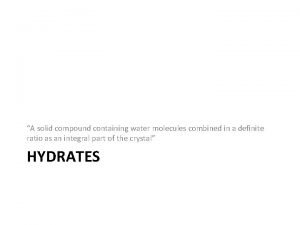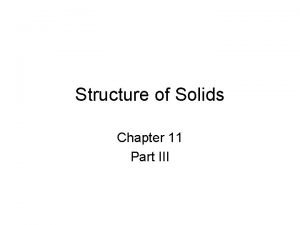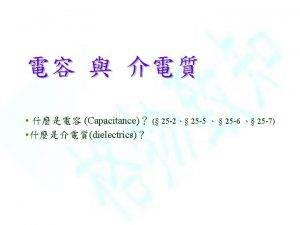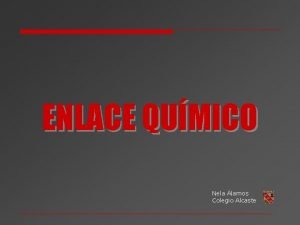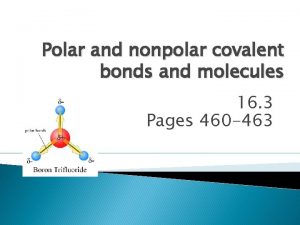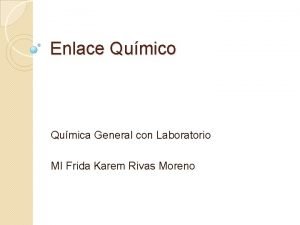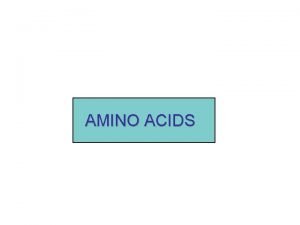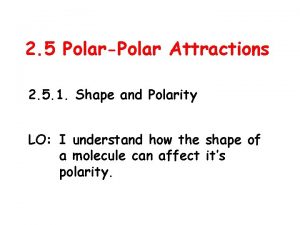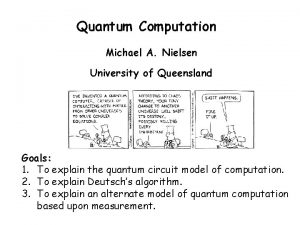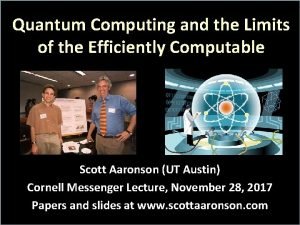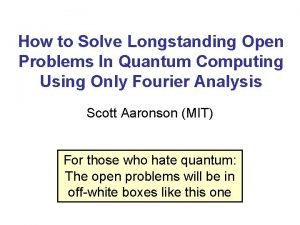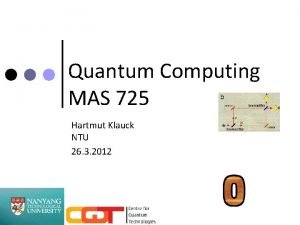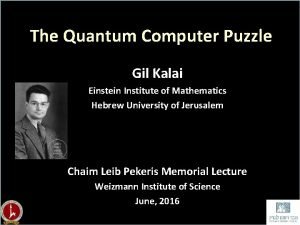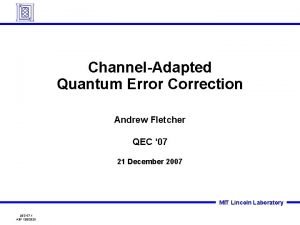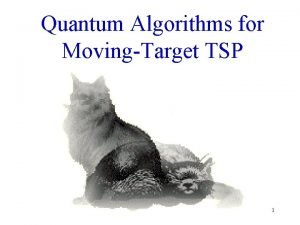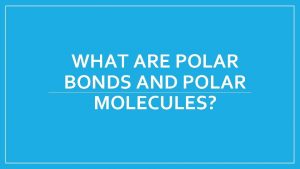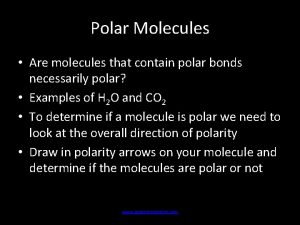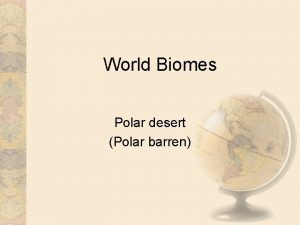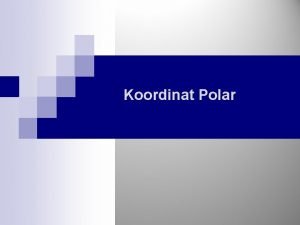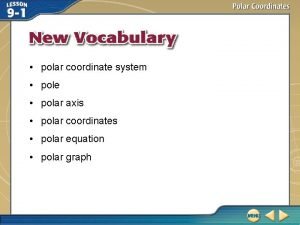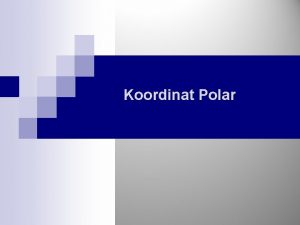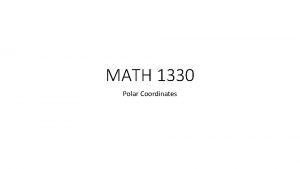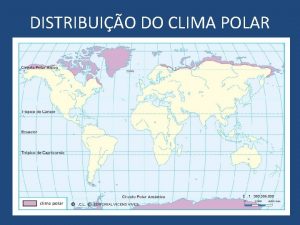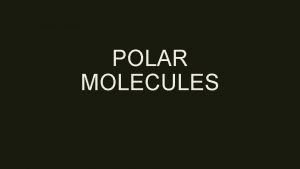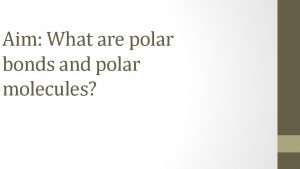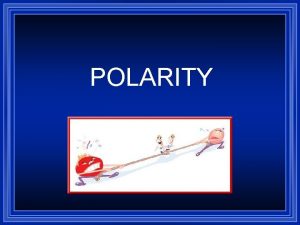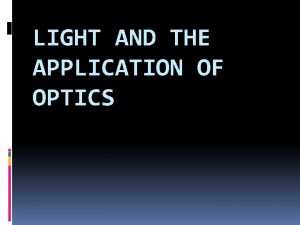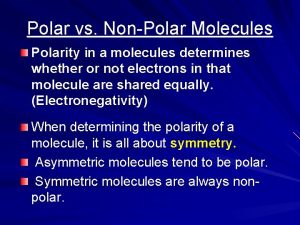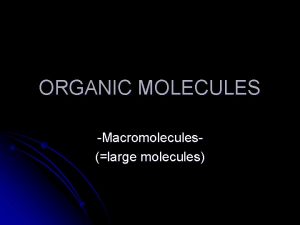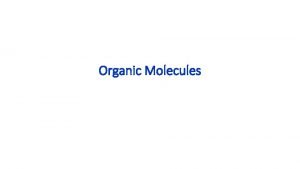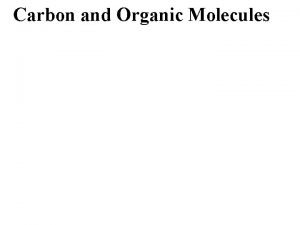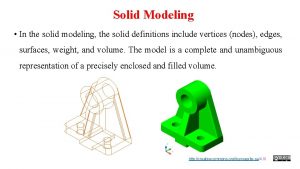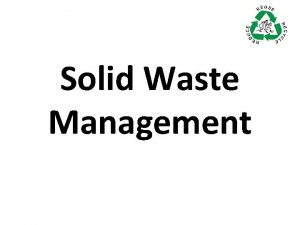Quantum Computing with Polar Molecules quantum optics solid




























- Slides: 28

Quantum Computing with Polar Molecules: quantum optics - solid state interfaces UNIVERSITY OF INNSBRUCK Peter Zoller A. Micheli (Ph. D student) P. Rabl (Ph. D student) H. P. Buechler (postdoc) G. Brennen (postdoc) Harvard / Yale collaborations: Misha Lukin (Harvard) John Doyle (Harvard) Rob Schoellkopf (Yale) Andre Axel (Yale) David De. Mille (Yale) AUSTRIAN ACADEMY OF SCIENCES SFB Coherent Control of Quantum Systems €U networks

Cold polar molecules exp: De. Mille, Doyle, Mejer, Rempe, Ye, … What‘s next in AMO physics? • Cold polar molecules in electronic & vibrational ground states – control & very little decoherence – F What new can we do? • AMO physics: – new scenarios in quantum computing & cold gases • electric dipole moments Interface AMO – CMP – example: superconducting circuits molecular ensembles / single molecules ü compatible setups & parameters ü strength / weakness complement each other

Quantum Optics with Atoms & Ions • Polar Molecules cold atoms in optical lattices laser rotation dipole moment • • trapped ions / crystals of … • • • CQED cavity atom • laser • atomic ensembles single molecules / molecular ensembles coupling to optical & microwave fields – trapping / cooling – CQED (strong coupling) – spontaneous emission / engineered dissipation interfacing solid state / AMO & microwave / optical – strong coupling / dissipation collisional interactions – quantum deg gases / Wigner (? ) crystals – dephasing

Polar molecules • basic properties

1 a. Single Polar Molecule: rigid rotor • single heteronuclear molecule – … N=2 "D" N=1 "P" N=0 "S" rigid rotor • F d d üdipole d~10 Debye ürotation B~10 GHz (anharmonic ) ü(essentially) no spontaneous emission (i. e. excited states useable) Strong coupling to microwave fields / cavities; in particular also strip line cavities

1 b. Identifying Qubits • • rigid rotor adding spin-rotation coupling (S=1/2) H = B N 2 + N·S H = B N 2 "D 5/2" "D" J=5/2 N=2 "D 3/2" N=2 "P" N=1 "P 1/2" "S" charge qubit • "P 3/2" N=1 N=0 How to encode qubits? J=3/2 N=0 J=3/2 J=1/2 "S 1/2" spin-rotation splitting J=1/2 spin qubit (decoherence) ``looks like an Alkali atom on GHz scale´´ (we adopt this below as our model molecule)

2. Two Polar Molecules: dipole – dipole interaction • interaction of two molecules features of dipole-dipole interaction ü long range ~1/R 3 ü angular dependence repulsion attraction ü strong! (temperature requirements)

What can we do with Polar Molecules? • a few examples & ideas

1. Hybrid Device: solid state processor & molecular memory + optical interface R. Schoelkopf, S. Girvin et al. see talk by A. Blais on Tuesday superconducting (1 D) microwave transmission line cavity (photon bus) Yale-type strong coupling CQED Cooper Pair Box (qubit)

P. Rabl, R. Schoelkopf, D. De. Mille, M. Lukin … 1. Hybrid Device: solid state processor & molecular memory + optical interface optical cavity molecular ensemble optical (flying) qubit laser superconducting (1 D) microwave transmission line cavity (photon bus) polar molecular ensemble 1: quantum memory (qubit or continuous variable) [Rem. : cooling / trapping] strong coupling CQED Cooper Pair Box (qubit) as nonlinearity polar molecular ensemble 2: quantum memory (qubit or continuous variable)

Trapping single molecules above a strip line • Three approaches: – magnetic trapping (similar to neutral atoms) – electrostatic trap: d. E interaction DC – microwave dipole trap: d. E interaction AC Andre Axel, R. Scholekopf M. Lukin et al. Electrostatic Z trap (EZ trap) • DC voltage: same trap potential for N=1, 2 states at ~10 k. V/cm 0. 1 mm • • • AC voltages: same trap potential for N=0, 1 states at “magic” detuning micron-scale electrode structure Goals – Trapping of relevant states h~0. 1 mm from surface – High trap frequencies ( > 1 -10 MHz) – large trap depths … Challenges: – Loading – no laser cooling (? ) @ h~0. 1 and t> 10 MHz – Interaction with surface shifts levels by less than 1% e. g. van der Waals interaction

Sideband cooling with stripline resonator (“ g cooling”) • “ g” cooling: position dependence of coupling g(r) to cavity gives rise to force • “ ” cooling: spatially uniform g but different traps in upper/lower states → gives rise to force |2> |1> engineered dissipation + analogy to laser cooling

2. Realization of Lattice Spin Models • A. Micheli, G. Brennen, PZ, preprint Dec 2005 polar molecules on optical lattices provide a complete toolbox to realize general lattice spin models in a natural way Examples: Duocot, Feigelman, Ioffe et al. Kitaev xx zz ZZ XX YY protected quantum memory: degenerate ground states as qubits • Motivation: virtual quantum materials towards topological quantum computing

3. (Wigner-) Crystals with Polar Molecules • “Wigner crystals“ in 1 D and 2 D (1/R 3 repulsion – for R > R 0) H. P. Büchler V. Steixner G. Pupillo M. Lukin … dipole-dipole: crystal for high density Coulomb: WC for low density (ions) 2 D triangular lattice (Abrikosov lattice) g(R) 1 st order phase transition solid liquid R Tonks gas / BEC WC (liquid / gas) mean distance quantum ~ 100 nm statistics

Applications: • compare: ionic Coulomb crystal Ion trap like quantum computing with phonons as a bus. d 1 d 2 /R 3 ion trap like qc, however: x phonons • • ü d variable ü spin dependent d ü qu melting / quantum statistics Exchange gates based on „quantum melting“ of crystal – Lindemann criterion x ~ 0. 1 mean distance – [Note: no melting in ion trap] (breathing mode indep of # molecules) Ensemble memory: dephasing / avoiding collision dephasing in a 1 D and 2 D WC – ensemble qubit in 2 D configuration – [there is an instability: qubit -> spin waves]

Quantum Optical / Solid State Interfaces

with P. Rabl, R. Schoelkopf, D. De. Mille, M. Lukin Hybrid Device: solid state processor & molecular memory + optical interface optical cavity molecular ensemble optical (flying) qubit laser superconducting (1 D) microwave transmission line cavity (photon bus) polar molecular ensemble 1: quantum memory (qubit or continuous variable) [Rem. : cooling / trapping] strong coupling CQED Cooper Pair Box (qubit) as nonlinearity polar molecular ensemble 2: quantum memory (qubit or continuous variable)

R. Schoelkopf, M. Devoret, S. Girvin (Yale) 1. strong CQED with superconducting circuits • Cavity QED SC qubit Jaynes-Cummings good cavity strong coupling! (mode volume V/ 3 ¼ 10 -5 ) • • “not so great” qubits [. . . similar results expected for coupling to quantum dots (Delft)] [compare with CQED with atoms in optical and microwave regime]

… with Yale/Harvard 2. . coupling atoms or molecules • superconducting transmission line cavities atoms / • hyperfine excitation of BEC / atomic ensemble molecules hyperfine structure » 10 GHz SC qubit • • Remarks: – time scales compatible – laser light + SC is a problem: we must move atoms / molecules to interact with light (? ) – traps / surface ~ 10 µm scale – low temperature: SC, black body… rotational excitation of polar molecule(s) N=1 rotational excitations » 10 GHz N=0 ensemble

3. Atomic / molecular ensembles: collective excitations as Qubits • ground state microwave • one excitation (Fock state) microwave harmonic oscillator • • • two excitations. . . eliminate? – in AMO: dipole blockade, measurements. . . nonlinearity due to Cooper Pair Box. etc. also: ensembles as continuous variable quantum memory (Polzik, . . . ) collisional dephasing (? )

4. Hybrid Device: solid state processor & molec memory molecules: qubit 1 SC qubit time independent molecules: qubit 2 ensemble qubits solid state system + dissipation (master equation) swap molecule cavity

5. Examples of Quantum Info Protocols • SWAP Cooper Pair cavity (bus) molec ensemble • Single qubit rotations via SC qubit • Universal 2 -Qubit Gates via SC qubit • measurement via ensemble / optical readout or SC qubit / SET Atomic ensembles complemented by deterministic entanglement operations

A. Micheli, G. Brennen & PZ, preprint Dec 2005 Spin Models with Optical Lattices • • we work in detail through one example quantum info relevance: – polar molecule realization of models for protected quantum memory (Ioffe, Feigelman et al. ) – Kitaev model: towards topological quantum computing

Duocot, Feigelman, Ioffe et al. Kitaev

Basic idea of engineering spin-spin interactions dipole-dipole: anisotropic + long range microwave spin-rotation coupling effective spin-spin coupling microwave

Adiabatic potentials for two (unpolarized) polar molecules • Spin Rotation ( here: /B = 1/10 ) Induced effective interactions: 0 g+ : 0 g{ : 1 g : 1 u : 2 g : 0 u : 2 u : S 1/2 + S 1 · S 2 { 2 S 1 c S 2 c + S 1 · S 2 { 2 S 1 p S 2 p + S 1 · S 2 { 2 S 1 b S 2 b { S 1 · S 2 + S 1 b S 2 b 0 0 for ebody = ex and epol = ez 0 g+ : 0 g{ : 1 g : 1 u : 2 g : +XX{YY+ZZ +XX+YY{ZZ {XX+YY+ZZ {XX{YY{ZZ +XX Feature 1. By tuning close to a resonance we can select a specific spin texture

Example: "The Ioffe et al. Model" • Model is simple in terms of long-range resonances … Rem. : for a multifrequency field we can add the corresponding spin textures. Feature 2. We can choose the range of the interaction for a given spin texture Feature 3. for a multifrequency field spin textures are additive: toolbox

Summary: QIPC & Quantum Optics with Polar Molecules • single molecules / molecular ensembles • coupling to optical & microwave fields – trapping / cooling – CQED (strong coupling) – spontaneous emission / engineered dissipation interfacing solid state / AMO & microwave / optical – strong coupling / dissipation collisional interactions – quantum deg gases / Wigner crystals (ion trap like qc) – WC / dephasing • •
 Difference between ray optics and wave optics
Difference between ray optics and wave optics Venn diagram of geometric optics and physical optics
Venn diagram of geometric optics and physical optics Organic molecules vs inorganic molecules
Organic molecules vs inorganic molecules Superconducting devices in quantum optics
Superconducting devices in quantum optics Clausius mossotti relation for dielectric
Clausius mossotti relation for dielectric Non polar molecules that include fats oils and cholesterol
Non polar molecules that include fats oils and cholesterol Similarities between polar and nonpolar molecules
Similarities between polar and nonpolar molecules Is h2o a polar molecule
Is h2o a polar molecule What is a polar molecule
What is a polar molecule Substance leds shape polarity
Substance leds shape polarity Polar molecules
Polar molecules Properties of solids and liquids
Properties of solids and liquids A solid compound that contains water molecules
A solid compound that contains water molecules Solid molecules
Solid molecules Difference between polar and nonpolar dielectrics
Difference between polar and nonpolar dielectrics Uniones metalicas ejemplos
Uniones metalicas ejemplos Polar vs nonpolar
Polar vs nonpolar Fqcolindres 2 eso
Fqcolindres 2 eso Amino acid r groups
Amino acid r groups Polar attractions are ...
Polar attractions are ... Origin of quantum mechanics
Origin of quantum mechanics Quantum physics vs quantum mechanics
Quantum physics vs quantum mechanics Nielsen quantum computing
Nielsen quantum computing Quantum computing
Quantum computing Open problems in quantum computing
Open problems in quantum computing Hartmut klauck
Hartmut klauck Gil kalai quantum
Gil kalai quantum Mit quantum computing
Mit quantum computing Tsp
Tsp



